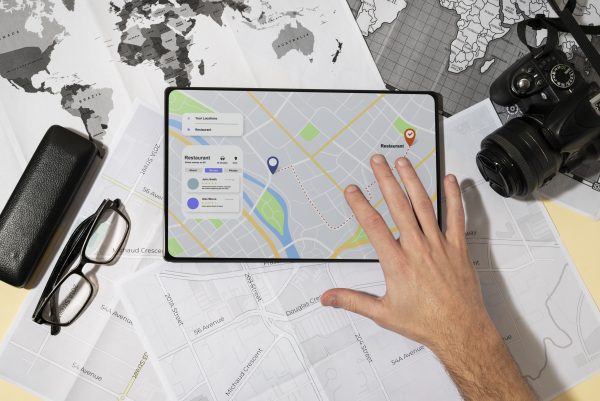Global Positioning System (GPS) tracking leverages a network of satellites orbiting the Earth to pinpoint the exact geographic location of a receiver on the ground. GPS tracking is employed in asset management to maintain real-time visibility of physical assets, irrespective of their location.
This capability is crucial for businesses that depend on the timely and efficient movement of goods, equipment, or mobile resources. When attached to assets, GPS tracking devices communicate location data to a central management system, providing managers with up-to-date information on the whereabouts and status of their assets.
This visibility is not just about knowing the location; it’s about gaining actionable insights that inform management decisions, leading to better asset utilization, increased efficiency, and cost savings. In this article, we’ll explore the significance of GPS technology in asset management, and how it can be used to positively impact your bottom line.
The Significance of Efficient Asset Management for Businesses
Asset management is an integral part of business operations that can affect the bottom line significantly. Managing assets efficiently means having control over the maintenance, utilization, and deployment of assets, which can range from vehicles and machinery to goods and equipment.
Efficient asset management ensures that assets are used properly and effectively, maintenance schedules are adhered to, and asset lifecycle costs are minimized. In the broader business context, this translates into improved customer satisfaction due to timely deliveries and services, reduced operational costs through optimal asset usage, and enhanced profitability by avoiding unnecessary expenditures on lost or underutilized assets.
The Impact of GPS Technology on Asset Management Strategies
Incorporating GPS technology into asset management strategies is nothing less than transformative. It has enabled a shift from reactive to proactive asset management. With GPS tracking, businesses are not only able to monitor asset movement but also predict patterns, plan maintenance, and optimize routes and usage.
The technology provides a level of detail and accuracy that was previously unattainable, such as the ability to monitor environmental conditions, detect unauthorized use, and provide instant alerts. This granular level of control over assets marks a paradigm shift in how businesses manage their resources, offering a competitive edge to those who harness the power of GPS tracking in their asset management strategies. The transformative impact extends across various industries, redefining norms and setting new benchmarks for operational efficiency and resource management.
Traditional Asset Management Practices
Asset management has historically been a manual and often cumbersome process, heavily reliant on paper trails and physical checks. Historically, businesses would keep logs and ledgers to record the movement and maintenance of assets. Physical inspections were routine, with managers and workers manually checking in on the status and condition of their resources.
Scheduling maintenance and tracking the utilization rates of assets often involved spreadsheets, if not pen and paper, which required regular updates and corrections. While these methods were standard practice, they were time-consuming and prone to human error, often resulting in incomplete or inaccurate asset tracking.

Challenges Associated with Legacy Systems
With their dependence on manual input and physical record-keeping, legacy systems presented numerous challenges for asset management. Key issues included the inability to track assets in real time, which often led to inefficient use of resources and difficulty in locating assets when needed. Furthermore, manual data entry was not only labor-intensive but also increased the likelihood of errors, making it difficult to maintain accurate asset inventories.
These systems were also unable to provide predictive insights, leaving businesses reactive rather than proactive when dealing with asset maintenance and management. The lack of integration between different asset management tools often resulted in siloed information, complicating the decision-making process and impeding effective communication within organizations.
Transition to Digital Asset Tracking Management Systems
Digital technology marked a significant turning point in asset management. The transition to digital asset management systems began with the computerization of records and the use of databases to track assets more efficiently. These systems allowed for better organization of data and somewhat streamlined the process of managing assets.
However, the real transformation came with the integration of technologies such as GPS tracking, which introduced a new level of functionality and control. Digital asset management systems equipped with GPS capabilities have automated the tracking process, delivering precise location data and enabling real-time visibility of assets.
This shift has not only eliminated many of the challenges associated with legacy systems but has also paved the way for advanced analytics, machine learning, and IoT integrations, thereby opening new frontiers in how assets are managed and optimized across various industries.
The Functionality of GPS Tracking
GPS tracking operates on a simple yet sophisticated principle: it uses a network of about 30 satellites orbiting the Earth to provide location and timing data to GPS receivers anywhere on the planet. These satellites, maintained by the U.S. Department of Defense, emit signals that are picked up by receivers, which can be integrated into various assets.
Each receiver calculates its distance from multiple satellites by the amount of time it takes to receive the transmitted signal. With data from at least four satellites, the receiver can determine its position in three dimensions—latitude, longitude, and altitude—with remarkable accuracy. This geolocation data is then typically communicated to a central server via cellular, satellite, or other wireless networks, enabling businesses to track their assets in real time.
Various GPS Tracking Devices Applicable in Asset Management
The range of GPS tracking devices suitable for asset management is diverse, accommodating the varied needs of different assets and industries. Basic trackers can report the location of an asset at regular intervals, while more advanced trackers can monitor additional information such as speed, direction, temperature, and even operator behavior.
Some devices are compact and portable, designed for small items or packages, while others are ruggedized for outdoor use on heavy equipment or in harsh environments. Certain GPS devices are battery-powered with long life spans, making them suitable for assets without their own power supply. Others are designed to be hardwired into vehicles or machinery, drawing power directly and providing continuous tracking.

The Benefits of GPS in Asset Tracking
- Accurate asset location in real-time. This level of tracking precision can lead to better asset utilization, as managers can make informed decisions on the deployment and routing of mobile assets, thus reducing idle times and increasing productivity.
- Improved asset security. Geo-fencing, for instance, allows managers to set boundaries for asset movement, and alerts can be set up for unauthorized use or deviations from planned routes.
- Predictive maintenance. Patterns of use and wear can be closely monitored, allowing for timely maintenance activities that can extend the lifespan of assets.
- Improved operations. The detailed data gathered from GPS tracking can feed into analytics platforms to help businesses refine operational workflows, optimize asset portfolios, and ultimately drive down costs while maximizing return on investment.
The Role of Real-Time Data in Monitoring Assets
Real-time data is the linchpin of modern asset management, thanks to GPS tracking. This constant stream of data allows businesses to monitor their assets with an unprecedented level of detail and immediacy. With real-time tracking, companies can ensure that assets are where they need to be at any given time, enhancing service delivery and operational efficiency.
The immediacy of this data also allows for quick response to unexpected events, such as rerouting vehicles around traffic delays in a transportation network, thereby reducing downtime and improving customer satisfaction. Moreover, real-time data enables continuous monitoring, which is crucial for maintaining control over assets across large geographical areas and in remote locations.
Enhancing the Precision of Asset Inventories and Audits
GPS tracking provides an accurate, time-stamped record of an asset’s location history, which significantly enhances the precision of asset inventories and audits. This level of detail ensures that asset listings are always current, reducing the risk of discrepancies and the need for time-consuming manual audits.
The accuracy of GPS data also helps in reconciling physical assets with financial records, an essential aspect of regulatory compliance and financial reporting. By integrating GPS tracking with asset management systems, businesses can maintain a real-time inventory that reflects the true value of their asset base.
Mitigating Risks Related to Theft and Loss
The threat of theft and loss is a significant concern for any business managing valuable assets. GPS tracking is a powerful deterrent to theft and an effective tool for recovery. Assets that are GPS-enabled can be monitored for unauthorized movement, and in the event of theft, their location can be tracked for swift recovery.
This capability not only mitigates financial losses but also minimizes the operational disruption that can result from the sudden unavailability of critical assets. GPS tracking can also be instrumental in lowering insurance premiums, as insurers recognize the reduced risk associated with GPS-protected assets.
Data-Driven Decision-Making Facilitated by GPS Insights
The insights gleaned from GPS data are invaluable in informing business decisions. Managers can analyze this data to gain a clear understanding of how assets are being used, identifying patterns that could indicate inefficiencies or opportunities for optimization. This might involve route optimization for transportation fleets, strategic redeployment of mobile equipment, or better planning of asset maintenance.
With the high-quality data provided by GPS tracking, businesses can move beyond reactive management to a proactive approach that anticipates issues and leverages opportunities. Ultimately, the integration of GPS data into decision-making processes leads to smarter investments in assets, improved resource allocation, and an overall increase in operational intelligence and strategic advantage.

GPS Tracking in Different Sectors
Adaptation and Advantages in Transportation and Logistics
GPS tracking has become a cornerstone of the transportation and logistics sector, providing companies with a way to manage their fleets more efficiently:
- Real-time tracking of vehicles, which helps in route optimization, leading to fuel savings and timely deliveries.
- Automated dispatching.
- Insights into driver behavior, promoting safety and efficiency.
- Enhances supply chain visibility, assuring customers of precise delivery times and improving overall customer satisfaction.
Application in Construction and Heavy Equipment Management
- Scheduling and utilization of machinery, ensuring equipment is in the right place at the right time and is being used to its fullest potential.
- Project planning, which can lead to significant cost savings.
- Anti-theft measures, as construction equipment is often left on-site and vulnerable to theft.
Transformation in Healthcare Equipment Tracking
- Maintaining real-time inventories of critical equipment. From hospital beds to portable diagnostic machines, tracking these assets ensures they are readily available when needed, which can be crucial in a high-stakes medical setting.
- Managing the distribution of pharmaceuticals, ensuring sensitive materials are transported within required conditions and timelines.
Advancements in Retail Inventory Oversight
- Improved oversight of goods from warehouse to delivery, reducing the risk of loss and enabling retailers to provide customers with up-to-date information on product availability and shipment tracking.
Management of Government and Public Assets
- GPS tracking facilitates the management of a diverse array of assets, from municipal vehicles to equipment used in public services like street cleaning and waste disposal.
- Ensures accountability and can improve response times for public services.
- Allows for transparent reporting to stakeholders and the public on the usage and deployment of assets, which is essential for maintaining trust in public institutions.
Merging GPS with the Internet of Things (IoT) for Comprehensive Asset Tracking
The convergence of GPS with the Internet of Things (IoT) has paved the way for a more sophisticated asset tracking ecosystem. IoT devices equipped with sensors provide not just location data but also a wealth of information about the asset’s condition and environment.
This combination enables the tracking of variables such as temperature, humidity, and motion, which are crucial for sensitive assets. When all these data points are collected, businesses can get a holistic view of their assets’ status in real time, enabling them to make well-informed decisions.
Synergizing GPS Tracking with RFID and Barcode Systems
Radio-Frequency Identification (RFID) and barcode systems are often used in tandem with GPS tracking to enhance asset management. While GPS provides location data, RFID tags and barcodes offer quick identification, item-level tracking, and easier inventory management.
When assets enter or leave a warehouse, RFID can automatically update the inventory, and GPS can then track the asset’s movement outside the warehouse. This integration creates a seamless tracking system from the point of origin to the destination.
Employing GPS Data in Artificial Intelligence and Predictive Analytics
The use of GPS data is becoming increasingly sophisticated through its integration with artificial intelligence (AI) and predictive analytics. AI can process vast amounts of GPS data to identify patterns, predict trends, and make recommendations.
For instance, in fleet management, predictive analytics can use historical GPS data to anticipate vehicle maintenance issues before they occur, effectively scheduling maintenance work and preventing costly downtimes.
Leveraging Cloud Computing for Enhanced GPS Asset Management
Cloud computing has revolutionized how GPS tracking data is stored, processed, and accessed. With cloud-based asset management solutions, GPS data can be accessed in real time from any device with an internet connection. This flexibility allows for remote asset management, collaborative decision-making, and scalability.
The cloud also offers robust data storage, backup, and recovery options, ensuring that critical GPS tracking data is always available when needed. Cloud platforms can effortlessly handle the vast influx of data from GPS and other sensors, making them an ideal backbone for comprehensive asset management systems.
Final Thoughts
GPS technology has dramatically reshaped the landscape of asset management, offering unparalleled accuracy, efficiency, and control. The real-time tracking capabilities and detailed reporting afforded by GPS systems have enabled businesses to achieve greater operational visibility, reduce costs, enhance security, and improve asset utilization.
The future of GPS technology in asset management is promising, with trends pointing towards even more precise tracking capabilities, enhanced integration with other technologies, and a greater emphasis on sustainable and ethical management practices. Businesses can expect to see ongoing improvements in GPS technology that will open up new possibilities for managing assets more effectively and with greater impact on bottom lines.
Now is the time to embrace the transformational power of GPS tracking systems. Contact our consultants and ask how you can gain a significant advantage through enhanced asset visibility, control, and intelligence. Don’t let the opportunity to revolutionize your asset management practices pass by; take action now to secure a more efficient, secure, and data-driven future.
